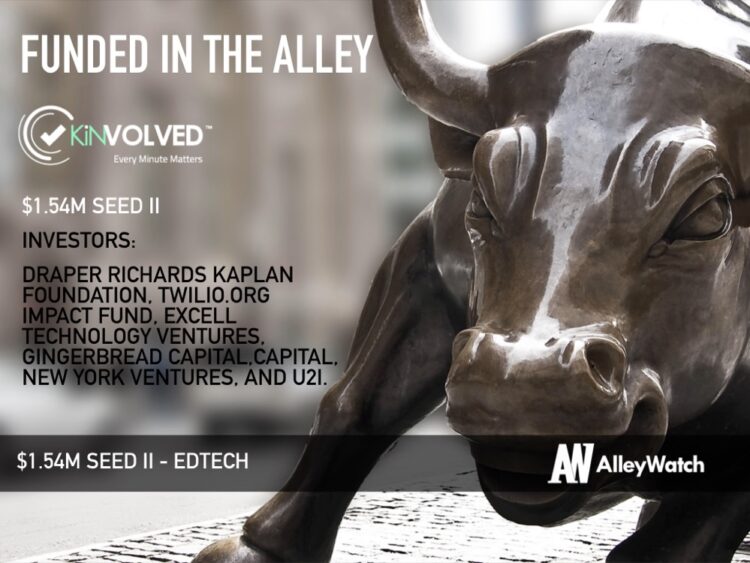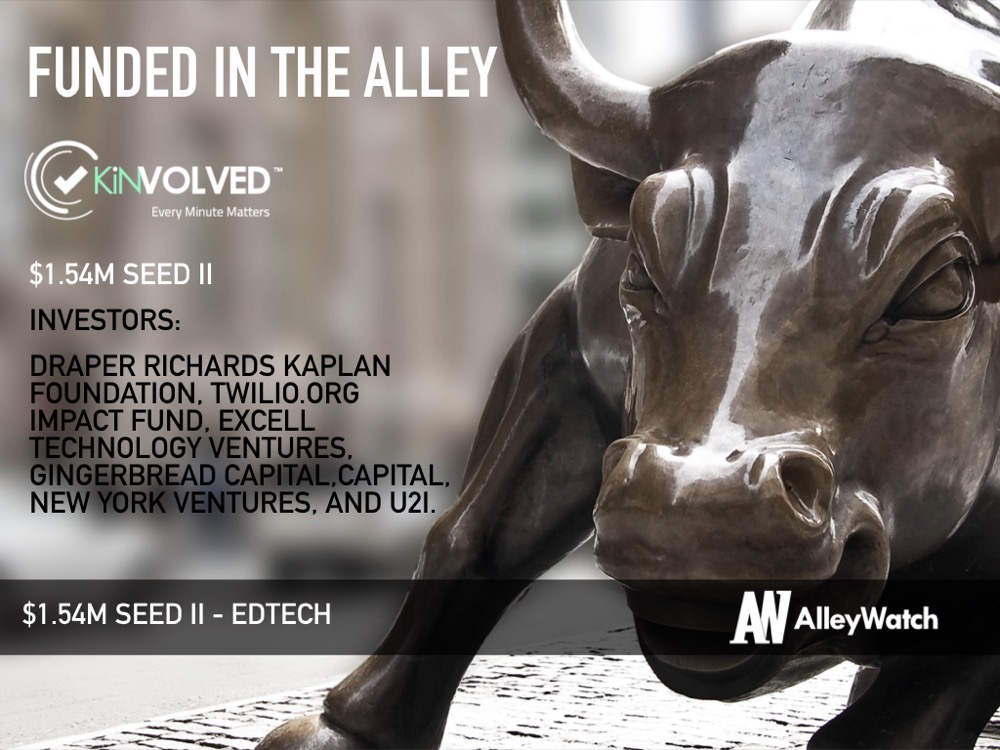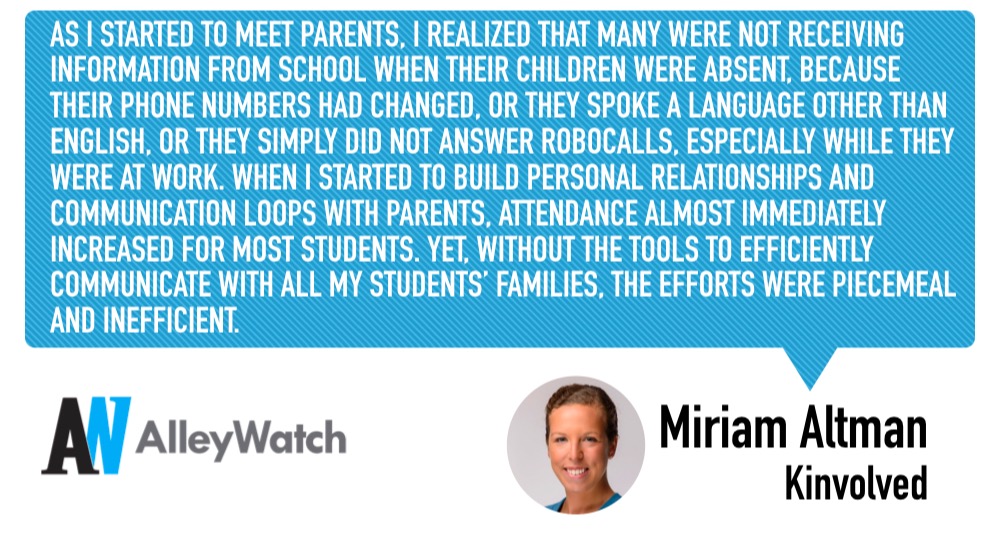Attendance is a leading indicator of a student’s success, and Kinvolved has created an innovative and holistic approach to combat student absenteeism. Kinvolved’s web and mobile applications directly integrate with each school districts’ systems of record and enable automated, two-way, translated SMS, email, and robocall communications. Their offering facilitates opening the lines of communication between school and home, creating a positive relationship. However, Kinvolved’s solution isn’t just technology-based, it also developed an intuitive school and district consulting curricula based on its Guide to Family Partnerships: Intention, Empathy, and Engagement to further prevent absenteeism. The company is already working with 150 public schools in NYC alone and has expanded its offering to school districts seven states.
AlleyWatch sat down with founder Miriam Altman to discuss building a socially mindful company that encourages engagement within education and the creation of safe, positive learning environments.
Who were your investors and how much did you raise?
We raised a $1.54M Seed II round, building on an earlier $1M Seed round and $500K in grants and awards-based funding.
The Draper Richards Kaplan Foundation (DRK)—a global venture philanthropy firm supporting early-stage, high-impact social enterprises—led this round with participation from Twilio.org Impact Fund, New York Ventures (VC arm of Empire State Development) Excell Technology Ventures, GingerBread Capital, and u2i. Several notable angel investors with industry knowledge and experience also participated in the round.
 47Tell us about the product or service that Kinvolved offers.
47Tell us about the product or service that Kinvolved offers.
Kinvolved is a social enterprise that takes a holistic approach to fight student absenteeism. Combining our technology tools and human interventions, we help bring increased funding to school districts, create more economically viable communities, and improve graduation rates.
Our primary product is KiNVO, a web and mobile application that directly integrates with school districts’ systems of record and enables automated, two-way, translated SMS, email, and robocall communications. Our product opens lines of communications, often for the first time, between school and home, breaking pre-existing barriers, engaging families, and creating positive school cultures. KiNVO also provides insights into student, class, school, and district attendance trends that inform interventions. Research and our own impact reporting proves that this method significantly improves student attendance.
However, knowing the education landscape well, we don’t believe that technology alone will solve absenteeism—a challenge that is often reflective of deep societal issues related to poverty, race, and equity. Thus, we have also developed a school and district consulting curricula based on our Guide to Family Partnerships: Intention, Empathy, and Engagement which complements the technology. We offer direct consulting to school systems, but also hold seminars and large community summits based on this curriculum.
What inspired you to start Kinvolved?
I started my career ten years ago as a high school history teacher in the NYC Department of Education. The most prominent and foundational challenge my students faced was inconsistent attendance—on any given day, easily one-third of my students missed or were late to class.
As I started to meet parents, I realized that many were not receiving information from school when their children were absent, because their phone numbers had changed, or they spoke a language other than English, or they simply did not answer robocalls, especially while they were at work. When I started to build personal relationships and communication loops with parents, attendance almost immediately increased for most students. Yet, without the tools to efficiently communicate with all my students’ families, the efforts were piecemeal and inefficient.
While I was teaching, my cofounder and Kinvolved’s chief product officer, Alexandra Meis, was working at Bronx Lebanon Hospital Center, where she and a pediatric neurologist developed a community support group for parents of children with autism. She quickly learned how deeply parents wanted to support and advocate for their children, but they had little access to basic information and this created barriers to involvement.
We met in 2011 at the Robert F. Wagner Graduate School for Public Service at NYU, where we developed Kinvolved as an entry into a policy challenge, which we won, in the spring of 2012. Using that funding, we launched a successful pilot of products at an NYC public school. Six years later, Kinvolved works with about 150 NYC public schools and has also expanded to school districts in seven states and the District of Columbia.
How is Kinvolved different?
While absenteeism as a concept is simple to understand, it is difficult to solve. This is because absenteeism is often an indicator of deep systemic problems surrounding poverty and inequity. Thus, a solution must either address these problems or work in spite of them.
When we started the company, few in our field recognized absenteeism, and even fewer believed that family engagement was possible, much less important. The good news is that federal policy, influenced by now decades of research, has proven that absenteeism is a problem significant enough that the Obama administration recognized it in the Civil Rights Data Collection. As a result, new federal policy, the Every Student Succeeds Act, has created more accountability for chronic absenteeism at the state and district level. This also means that more competitors are coming up with solutions.
However, Kinvolved was the original edtech company built to eradicate absenteeism. We were one of the first to market, and we have six years of hard work behind us that has led us to develop a proven formula that works.
Tactically, we compete with student information systems, the systems of record with which we integrate. We make these systems even more valuable to districts by putting the attendance data they store into action. We are displacing older enterprise communications systems that rely on one-way robocalling, and we offer peace of mind to district leaders who are concerned about educators using independent cell phones or individual apps to communicate with families sans oversight.
Tactically, we compete with student information systems, the systems of record with which we integrate. We make these systems even more valuable to districts by putting the attendance data they store into action. We are displacing older enterprise communications systems that rely on one-way robocalling, and we offer peace of mind to district leaders who are concerned about educators using independent cell phones or individual apps to communicate with families sans oversight.
Further, our strategic consulting and high-touch support means that teachers and administrators understand how to best leverage our tools, and we are able to prove impact. As a result, our annual contract renewal rates are higher than 90 percent.
What market does Kinvolved target and how big is it?
Kinvolved works with districts as small as 5K students and as large as 1.1M. These districts often enroll a significant population of students who qualify for Title I funding (federal funding to support students from under-resourced communities). As we are growing and continually iterating on our product—and while districts of all sizes and demographics, spanning the country, are becoming more accountable to attendance and family engagement—our market has continued to grow.
What’s your business model?
We charge an annual, per-student license for KiNVO. For our professional services, we offer different packages based on the level of support and district size. Our community summits are one-time, customized events.
Do most of the schools participating in Kinvolved see their students go on to enroll and complete 4-year universities?
We have been most focused on attendance improvement, as research from the Johns Hopkins Everyone Graduates Center proves that attendance is the most critical leading indicator of high school graduation. Our 2018 Impact Report will come out in early-2019, but based on previous years’ public attendance data, we know that our schools increase average daily attendance (ADA) 13 times better than their peers. In fact, we built an attendance calculator for school districts to see the annual funding they can bring in by working with Kinvolved to increase attendance at this rate.
Further, we know that, while chronic absence increased eleven percent in NYC schools last year, it decreased by three percent among our partner schools. This year, early results from our national district partners in Sioux Falls, South Dakota and Meriden, Connecticut, already show that chronic absence is decreasing significantly in their first year working with Kinvolved.
What are the biggest challenges that you faced while raising capital?
I would not say that raising this round was easy. However, given our traction, familiarity with the process, strong lead investor, and the development of the impact investing market since the first seed round we closed in 2015, the process was much smoother.
We are often a “first” for funders—education is a market with sales cycles that turn off most traditional venture capitalists, and social impact investors and philanthropists are used to making grants to nonprofits.
With the partnership of a very strong lead investor, the Draper Richards Kaplan Foundation (DRK), we were able to convince several investors to get involved in this financing round. Often, I would tell the story of the company, explain how the market works, while Stephanie Khurana, Managing Director at DRK, would explain why the investment was a smart social and financial move, as well as the functional technicalities of making the investment for funders unfamiliar with for-profit investing.
What factors about your business led your investors to write the check?
We are very happy with the group of investors we brought in on this round. According to these investors, Kinvolved was a particularly appealing opportunity because of the impact we’ve proven; our traction; the unique success we have experienced in both acquiring new, district (rather than individual school) sales; and our high rate of retaining existing district clients—all of which is unique among edtech companies.
Where do you see the company going now over the near term?
We are focused on growth in the next six months and beyond. We aim to double the number of students we serve, however, top-line growth is not our sole focus. We are also bolstering our tech and services so that we can continue to maintain our positive relationships and strong reputation among current and prospective district partners, as well as continual impact on students and families.
What advice can you offer companies in New York that do not have a fresh injection of capital in the bank?
While an infusion of capital is sometimes necessary, and with capital should come helpful strategic investors, the company’s primary focus should always remain on the customer. Stay as lean as you can; the longer you can wait before raising a first or subsequent round of funding, the better.
What’s your favorite restaurant in the city?
Cooking for friends or family is one of my favorite activities. When I go out, I often try new restaurants, so I can’t say I have a top choice!





